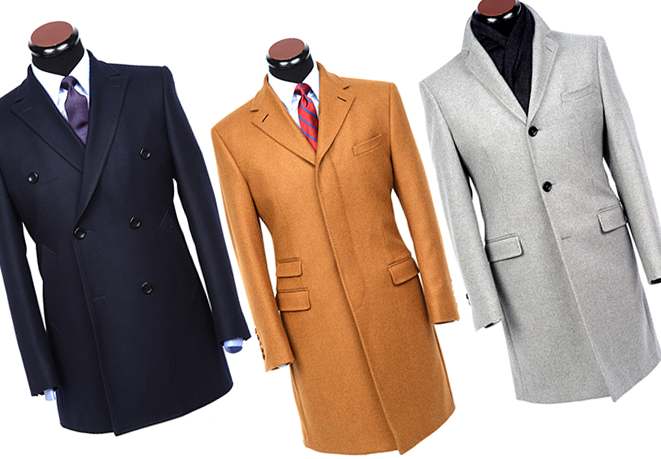An overcoat is a sleeved outer garment designed primarily for warmth.
There are basically three kinds of men’s overcoat:
- An overcoat is a long coat with sleeves that is worn on top of something else.
- A topcoat is a lightweight overcoat (a raincoat is an even lighter garment, made from a fabric that is designed to keep you dry rather than warm).
- A greatcoat is a heavy, bulky overcoat with a military history and military accoutrements.
Some classic overcoat styles have made their mark in the history of men’s clothing history. As such, these styles are basically timeless; look out for them.
Chesterfield.
Invented in the mid-19th century and named for the Earl of Chesterfield, this overcoat was the first modern version of the military coat. It features:
- No waist seams or front darts (previously those were the norm)
- Single-breasted front
- Short, notched lapel
- Straight side pockets – could be jetted, could be a flap pocket
- No cuffs
- Single back vent
- Typically knee-long
- Normally grey or charcoal.
Covert Coat.
This overcoat is designed for hunting and the outdoor life. It was made from a heavy, sturdy, durable material to protect its wearer from mud, scrub and the weather. Today’s Covert coat usually has these characteristics:
- Robust Tweed
- Brownish-green colour (because it does not show the dirt so much
- Single-breasted with a fly front
- Notched lapels
- Length just a little more than the jacket beneath
- Four or five lines of stitching at the cuffs and hem, and optionally on the flap of the chest pocket
- Centre vent
- Two flap pockets
- Poacher’s pocket (large inside pocket)
Trench Coat.
This classic was devised by Burberry in World War One and has evolved into a raincoat that is second to none. The Trench coat was originally made of gabardine, a durable wool fabric developed by Burberry to repel water and keep the wearer warm; a wool blanket insert also helped. Today’s Trench coat is more likely to use a heavy-duty cotton blend that may include gabardine and manmade fibres for maximum weather resistance; leather has also been used. These are the common style features you should look for in a classic men’s trench coat:
- Double breasted front with six to ten buttons depending on length
- Single back vent
- Raglan sleeves
- Epaulets (shoulder tabs)
- Storm flap – a protective flap on the right side for men that prevents rainwater from slipping into the jacket as it runs down the shoulders
- Detachable belt
- Cuff straps to tighten the fit and keep the rain out
- Khaki or navy blue color (though many other colors are used)
Paletot
This fairly short fitted overcoat carries a French word that basically covered a variety of overcoat styles. These days a Paletot is a classic business overcoat with the following features:
- Double-breasted with two rows of six buttons
- The top buttons are not intended to do up and are set wider apart than the functional buttons
- Peaked lapels
- Fitted or semi-fitted, cut with a noticeable waist
- Flat back with no vent
- No belt
Guards coat:
Derived from the officers’ coat of the Brigade of Guards, today the Guards coat is usually a navy blue overcoat that is very similar to the Paletot:
- Double-breasted with two rows of six buttons
- Peaked lapels
- Fitted or semi-fitted, cut with a noticeable waist
- Flat back with no vent
… but with two basic differences:
- A half belt across the back
- It can be buttoned with three buttons or just two
Ulster:
This is a classic heavy overcoat, derived from the Irish province of Ulster where the weather can be quite demanding. The overcoat’s features include:
- Roomy and rather long styling
- Double-breasted with six or eight buttons
- Ulster collar (lapels that are notched so that they can easily be folded over to keep out the weather when the coat is buttoned up all the way)
- Large patch pockets
- Cuffs
- Made out of heavy, durable Donegal tweed (characterized by its rustic, hand-woven look and multicolored dots)
- An adjustable half-belt across the back.
Polo coat.
This overcoat is an American classic that originated from polo players in England who keep warm between chukkas by wearing a tan wrap-coat very similar to an Ulster. A modern Polo Coat has the following characteristics:
- Made of golden or tan-colored material, either camel hair or a 50/50 blend with wool
- Belted, either a half-belt or a full belt
- Six or eight buttons in a single row
- Patch pockets
- Peaked lapels or an Ulster collar with optional cuffs.
